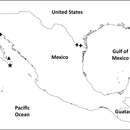en
names in breadcrumbs


The spider family Caponiidae (bright lungless spiders), the members of which are found mainly in the Americas and southern Africa, includes 86 described species (Platnick 2013), with only around eight to ten species recorded from North America north of Mexico.
Caponiids are morphologically unusual in a number of ways. They differ from other spiders in lacking book lungs and having the posterior median spinnerets anteriorly displaced to form a transverse row with the anterior lateral spinnerets. Most species have only two eyes (although the ancestral state for the group is to have eight eyes) and, unlike other spiders showing eye loss, they retain the anterior median eyes.
Caponiids are wandering hunters, typically found on the ground, under rocks, and in leaf litter. Some species are known only from Neotoma woodrat nests. Most of the Nearctic species live in arid deserts or desert scrub (Orthonops and Tarsonops), whereas others (the single species of Calponia, some Orthonops) occur in habitats ranging from oak savanna to closed canopy forests. Caponiids are believed to favor other spiders as food, although at least in the lab their diet is not restricted to spiders.
Calponia harrisonfordi was described (from California, where it is endemic to the central California Coast Ranges) only in 1993 (Platnick 1993). Spiders of this species (which was named in honor of the American film actor Harrison Ford, a generous supporter of the American Museum of Natural History) have eight eyes. Orthonops was revised by Platnick in 1995.
(Ubick 2005; Bradley 2013)
Caponiidae is a family of ecribellate haplogyne spiders that are unusual in a number of ways. They differ from other spiders in lacking book lungs and having the posterior median spinnerets anteriorly displaced to form a transverse row with the anterior lateral spinnerets. Most species have only two eyes, which is also unusual among spiders. A few species of Caponiidae variously have four, six or eight eyes. In some species the number of eyes will increase when the spiderling changes its skin as it grows towards adulthood.
These spiders of about 2 to 5 millimetres (0.079 to 0.197 in) are rarely noticed, but generally look like somewhat faded woodlouse hunter spiders in the genus Dysdera. The carapace (cephalothorax or prosoma) is orange and the abdomen (opisthosoma) light gray. The two-eyed species have their two eyes in the anterior middle of the carapace.
Caponiidae are unusual in the degree to which the eye number varies. In this they surpass even the family Cybaeidae in which some species have two eyes, some six, and some eight. In some species of the Caponiidae paired eyes meet in the midline, giving the spider in effect, an odd number of eyes. The following genera have eyes as follows:
Their habits are for the most part unknown. At least some species are known to hunt other spiders.
The fact that they are ecribellate and haplogyne suggests that they might be relatively primitive. Calponia harrisonfordi from California seems to be the most primitive member of the family. Their phylogenetic relationships have long been enigmatic, but in the early 1990s it was determined that they are probably a sister group of the Tetrablemmidae plus the four families inside the superfamily Dysderoidea.
The subfamily Nopinae consists at least of the genera Nops, Nopsides, Orthonops and Tarsonops. The remaining genera are unlikely to form a monophyletic group.
The family is found in Africa and the Americas from Argentina to the United States.
Calponia is a contraction of Californian Caponia, because the single species Calponia harrisonfordi has, like the African genus Caponia eight eyes. The species name is in honor of Harrison Ford, recognizing his efforts on behalf of the American Museum of Natural History.
The Chilean caponiid fauna differs from that of the rest of the Neotropics in lacking members of the Nopinae (named after the genus Nops). Three genera newly described by Norman I. Platnick in 1994 were thus named Notnops, Taintnops and Tisentnops, emphasizing this fact. The only Taintnops species, T. goloboffi, is named in honor of one of the collectors, P.A. Goloboff.
As of April 2019, the World Spider Catalog accepts the following genera:[1]
Caponiidae is a family of ecribellate haplogyne spiders that are unusual in a number of ways. They differ from other spiders in lacking book lungs and having the posterior median spinnerets anteriorly displaced to form a transverse row with the anterior lateral spinnerets. Most species have only two eyes, which is also unusual among spiders. A few species of Caponiidae variously have four, six or eight eyes. In some species the number of eyes will increase when the spiderling changes its skin as it grows towards adulthood.